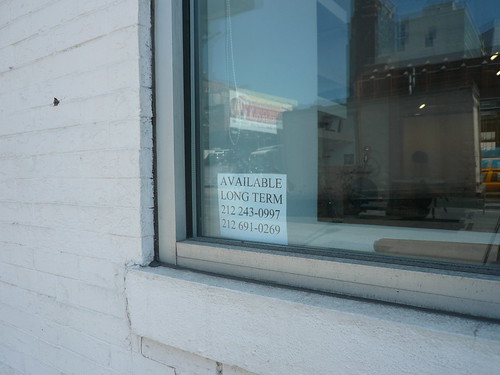Image Via
Today’s well attended ARTspace panel, “Making a Living as an Artist: With or Without a Dealer,” was lively and informative as all get-out. Organized and chaired by artist Sharon Louden, it brought to bear the expertise of a number of New York City’s finest art mavens: the artist and writer Sharon Butler, whose well appointed blog Two Coats of Paint will be familiar to many readers here; artist, former gallery director, curator and current Director of the Elizabeth Foundation for the Arts Studio Program Bill Carroll; artist, curator and current Dean of The New York Academy of Art Peter Drake; and New York dealer, inveterate blogger and author of How to Start and Run a Commercial Art Gallery Ed Winkleman.
[Full disclosure: I am represented by Winkleman Gallery; Sharon Butler, a fellow painter, is the author of one of my favorite art blogs, where she recently wrote a thoughtful review of my last show; Sharon Louden -- well, Sharon is every artist's hero (she's been mine for quite some time); and Bill Carroll and Peter Drake aren't exactly chopped liver! Basically, there was no way I was going to miss this panel...]
Here is an encapsulation of the discussion (paraphrased) — I’ve divided it up into several posts:
Sharon Louden: Everyone here on the panel wears a number of different hats; some of them have been through many dips in the economy before. My interest in gathering you together here is to explore how artists themselves have the power to weather these dips, and the kinds of partnerships that might help that process.
Bill Carroll: It is very difficult to make a living as an artist. You need a fallback, as it really is like a lottery. During a downturn, having a gallery may even be irrelevent if they can’t sell your work. Interestingly, more galleries closed during the 90s downturn than in this recent one. Back then, the mid-career artists were hit hardest — that market completely died. One of our artists [at Charles Cowles Gallery] who was a sculptor turned entirely to public commissions and it changed his career in a very positive way. He still makes sculpture, but public commissions have since become an important part of what he does.
Ed Winkleman: I have two collectors who’ve been collecting art for 35 years. When the downturn hit in 2008 they said: we just don’t know the real price of anything right now, and we’re going to hold off buying until we can determine which prices have been inflated. So, one thing artists can do in response to such a situation is to put out a new body of work with lower prices — if you are a painter, you might create a new series of drawings, for example — and get those out and into the market, rather than having to lower the prices of your existing body of work.
Sharon Butler: As an artist I want to remind people — I think many people forget — that artists have a lot of skills. In the last downturn, I decided to go to graduate school. I managed to get a scholarship and a stipend, and I treated it like a residency.
Peter Drake: If you’re in this room you are already proactive — artists and creative people taking control of their lives. I think of Jeffrey Lew and Gordon Matta-Clark and what they did when they established 112 Green Street.…
Image Via
Sharon L: Artists come to me and they ask: how do you get a dealer? But is having a dealer the answer? Is it key? Why is that perceived need there?
Sharon B: Having a dealer is only part of the puzzle of being an artist. Don’t put all your eggs in that basket. Even with gallery representation, you have to do things yourself. The reality is, THERE AREN’T ENOUGH GALLERIES to accommodate all the artists [and, it's intimated, not enough collectors - not enough demand].
Bill: You are ALWAYS responsible for your own career. A smaller gallery especially cannot be working on your career all the time. Most of the people I now who make a living off their work have several galleries — you need to look for galleries in other cities outside New York City.
Ed: There’s a sense you get, looking at submissions, that many artists think getting a gallery is an end-goal. Also, artists need to think in terms of working with a team — with their gallery. Especially during a downturn.
Bill: Many artists come into a gallery and think they’ve found parents (laughter).
Peter: There are many different “art worlds’… in any case it really is a partnership you enter into with your dealer. You have to adjust to make sure your partnership stays whole. You also have to help them extend their reach. To reciprocate, many dealers will ask their artists to curate shows.
To be continued… Part Two




Pingback: Making a Living as an Artist (With or Without a Dealer) – part 2 | 2011 CAA Annual Conference Blog
An art gallery that handles more than 20 artists cannot cater to specific needs of one particular artist, I understand that.
Why do they seem to abandon you when sales are down?
Pingback: Weekend Links: Degradation and Redemption | Stephanie Vegh